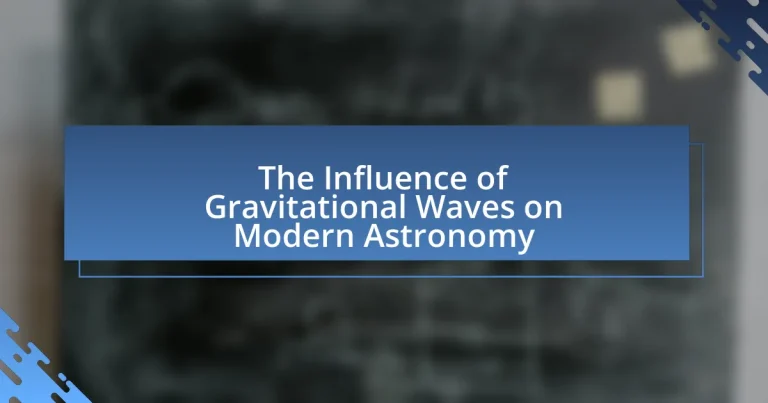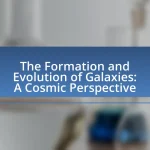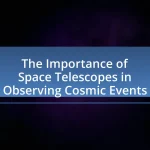Gravitational waves are ripples in spacetime generated by the acceleration of massive objects, such as merging black holes and neutron stars. Their detection has revolutionized modern astronomy by providing a new observational method for studying cosmic events that are otherwise invisible through traditional electromagnetic means. This article explores the significance of gravitational waves in understanding the universe, detailing how they are produced, the astronomical events that generate them, and their implications for cosmology and astrophysics. Additionally, it discusses advancements in detection technology, the challenges faced in gravitational wave astronomy, and the interdisciplinary collaborations emerging from this field.
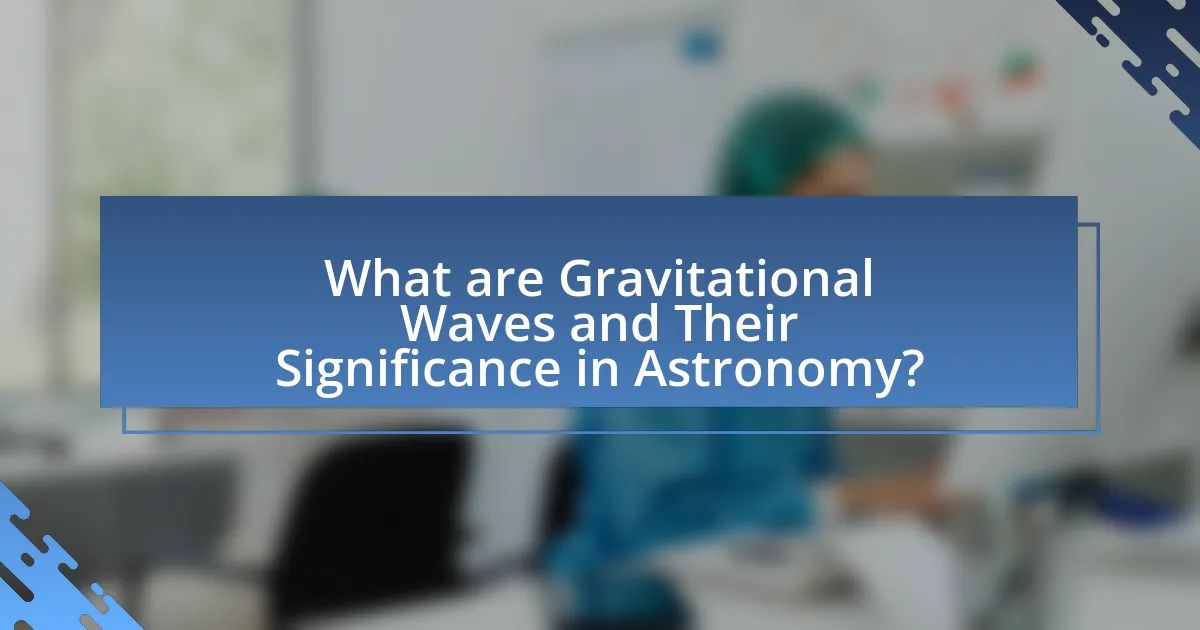
What are Gravitational Waves and Their Significance in Astronomy?
Gravitational waves are ripples in spacetime caused by the acceleration of massive objects, such as merging black holes or neutron stars. Their significance in astronomy lies in their ability to provide a new method of observing cosmic events that are otherwise invisible through traditional electromagnetic observations. The detection of gravitational waves, first confirmed by the LIGO observatory in 2015, has opened a new window into the universe, allowing scientists to study phenomena like black hole mergers and neutron star collisions, which contribute to our understanding of fundamental physics and the evolution of the universe. This groundbreaking discovery has led to the establishment of gravitational wave astronomy as a vital field, enhancing our knowledge of the cosmos and confirming aspects of Einstein’s general theory of relativity.
How are Gravitational Waves Generated?
Gravitational waves are generated by the acceleration of massive objects, particularly during events such as the merging of black holes or neutron stars. When these massive bodies accelerate, they create ripples in spacetime that propagate outward at the speed of light. The first direct detection of gravitational waves by the LIGO observatory in 2015 confirmed their existence, originating from a binary black hole merger approximately 1.3 billion light-years away. This detection provided concrete evidence that such cosmic events produce gravitational waves, validating predictions made by Albert Einstein’s General Theory of Relativity.
What astronomical events produce Gravitational Waves?
Gravitational waves are produced by astronomical events such as the merger of black holes, the collision of neutron stars, and supernova explosions. These events generate ripples in spacetime due to the acceleration of massive objects, as confirmed by the detection of gravitational waves from the first observed black hole merger by LIGO in 2015. This event demonstrated that such mergers can create detectable gravitational waves, validating the predictions made by Einstein’s general theory of relativity.
How do these events relate to the fabric of spacetime?
Gravitational waves are ripples in the fabric of spacetime caused by accelerating massive objects, such as merging black holes or neutron stars. These events directly distort spacetime, creating fluctuations that propagate at the speed of light, as described by Einstein’s General Theory of Relativity. The detection of gravitational waves by observatories like LIGO and Virgo provides empirical evidence of these spacetime distortions, confirming that massive cosmic events can influence the structure of spacetime itself.
Why are Gravitational Waves Important for Modern Astronomy?
Gravitational waves are important for modern astronomy because they provide a new way to observe and understand cosmic events that are otherwise invisible through traditional electromagnetic observations. These ripples in spacetime, first detected by LIGO in 2015, allow astronomers to study phenomena such as black hole mergers and neutron star collisions, which emit significant energy in the form of gravitational waves rather than light. This capability enhances our understanding of the universe’s most violent and energetic processes, offering insights into the formation and evolution of celestial bodies. The detection of gravitational waves has opened a new observational window, enabling multi-messenger astronomy, where information from gravitational waves is combined with electromagnetic signals to create a more comprehensive picture of cosmic events.
What new insights do Gravitational Waves provide about the universe?
Gravitational waves provide new insights into the universe by allowing scientists to observe cosmic events that were previously undetectable, such as the merging of black holes and neutron stars. These waves carry information about the extreme conditions of these events, enabling researchers to study the properties of black holes, the behavior of matter under intense gravity, and the formation of heavy elements through neutron star collisions. For instance, the detection of gravitational waves from the merger of two black holes by LIGO in 2015 confirmed predictions made by Einstein’s general theory of relativity and opened a new era of multi-messenger astronomy, where gravitational waves complement electromagnetic observations. This capability enhances our understanding of the universe’s evolution, structure, and the fundamental laws of physics.
How do they complement traditional astronomical observations?
Gravitational waves complement traditional astronomical observations by providing a new method to detect and study cosmic events that are otherwise invisible to electromagnetic radiation. While traditional observations rely on light and other electromagnetic signals, gravitational waves allow astronomers to observe phenomena such as black hole mergers and neutron star collisions, which emit little to no light. For instance, the detection of gravitational waves from the merger of two black holes by LIGO in 2015 marked the first observation of such an event, revealing information about the masses and spins of the black holes involved. This dual approach enhances our understanding of the universe by offering insights into the dynamics of extreme astrophysical processes that cannot be captured through traditional means alone.
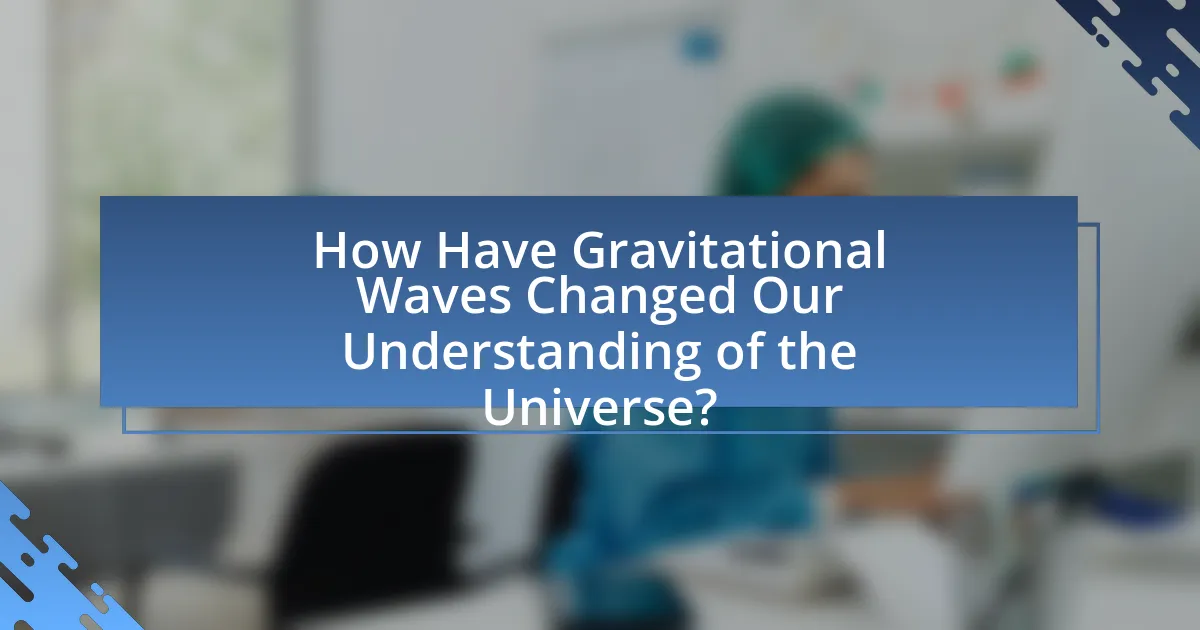
How Have Gravitational Waves Changed Our Understanding of the Universe?
Gravitational waves have fundamentally transformed our understanding of the universe by providing a new method of observing cosmic events. Detected for the first time in 2015 by the LIGO observatory, these ripples in spacetime have confirmed predictions made by Einstein’s general theory of relativity and opened a new era in astrophysics. The observation of gravitational waves from merging black holes and neutron stars has allowed scientists to study phenomena that are invisible to traditional electromagnetic observations, such as light. This has led to significant discoveries, including the confirmation of the existence of binary black hole systems and insights into the behavior of matter under extreme conditions. The ability to detect and analyze gravitational waves has thus expanded our knowledge of the universe’s structure, evolution, and the fundamental laws of physics.
What discoveries have been made through Gravitational Wave astronomy?
Gravitational Wave astronomy has led to significant discoveries, including the detection of binary black hole mergers and neutron star collisions. The first detection, GW150914, confirmed the existence of merging black holes, providing evidence for Einstein’s General Theory of Relativity. Subsequent observations, such as the neutron star merger GW170817, not only confirmed the production of heavy elements like gold but also marked the first observation of gravitational waves and electromagnetic signals from the same event, demonstrating the potential for multi-messenger astronomy. These findings have revolutionized our understanding of cosmic events and the fundamental nature of gravity.
How has the detection of binary black hole mergers impacted astrophysics?
The detection of binary black hole mergers has significantly advanced astrophysics by providing direct evidence for the existence of black holes and confirming predictions of general relativity. This groundbreaking achievement, first realized by the LIGO observatory in 2015, has enabled scientists to observe cosmic events that were previously undetectable, thus expanding our understanding of the universe. The observation of gravitational waves from these mergers has allowed researchers to study the population and formation mechanisms of black holes, revealing that they can form from massive stars and evolve through various processes. Additionally, the data collected from these events has led to new insights into the rate of black hole mergers, estimated to be around 100 per year in our observable universe, which has implications for the evolution of galaxies and the distribution of matter in the cosmos.
What role do Gravitational Waves play in understanding neutron stars?
Gravitational waves play a crucial role in understanding neutron stars by providing direct evidence of their existence and properties through the detection of their mergers. When neutron stars collide, they emit gravitational waves that can be measured by observatories like LIGO and Virgo, allowing scientists to infer key characteristics such as mass, spin, and the equation of state of nuclear matter. For instance, the observation of the neutron star merger event GW170817 not only confirmed the existence of kilonovae but also provided insights into the formation of heavy elements like gold and platinum, demonstrating the importance of gravitational waves in advancing our knowledge of neutron stars and their astrophysical processes.
How do Gravitational Waves influence the study of cosmology?
Gravitational waves significantly influence the study of cosmology by providing a new method to observe and understand the universe’s structure and evolution. These ripples in spacetime, first detected by LIGO in 2015, allow astronomers to study events such as black hole mergers and neutron star collisions, which were previously undetectable through electromagnetic observations. This capability enhances our understanding of cosmic phenomena, including the rate of expansion of the universe and the formation of galaxies. Furthermore, gravitational waves can offer insights into the early universe, potentially revealing information about cosmic inflation and the conditions that existed shortly after the Big Bang. The integration of gravitational wave data with traditional astronomical observations enriches cosmological models and helps refine parameters such as the Hubble constant, thereby improving our comprehension of the universe’s history and dynamics.
What can Gravitational Waves tell us about the early universe?
Gravitational waves can provide insights into the conditions of the early universe, particularly during the moments following the Big Bang. These ripples in spacetime, predicted by Einstein’s general theory of relativity, can carry information about high-energy events such as cosmic inflation, which occurred within the first fractions of a second after the universe began. Observations from detectors like LIGO and Virgo have the potential to reveal signatures of primordial gravitational waves, which would indicate the energy scale of inflation and help scientists understand the dynamics of the early universe. The detection of these waves would support theories of cosmic evolution and enhance our understanding of fundamental physics, as they are directly linked to the state of the universe at its inception.
How do they help in measuring cosmic distances?
Gravitational waves help in measuring cosmic distances by providing a new method of distance measurement through the observation of their effects on spacetime. When two massive objects, such as black holes or neutron stars, collide, they emit gravitational waves that can be detected by observatories like LIGO and Virgo. The amplitude and frequency of these waves are directly related to the distance of the source from Earth, allowing astronomers to calculate how far away these cosmic events occur. This method complements traditional distance measurement techniques, such as the use of standard candles like supernovae, by offering a direct measurement of distances in the universe, particularly in regions where traditional methods may be less effective.
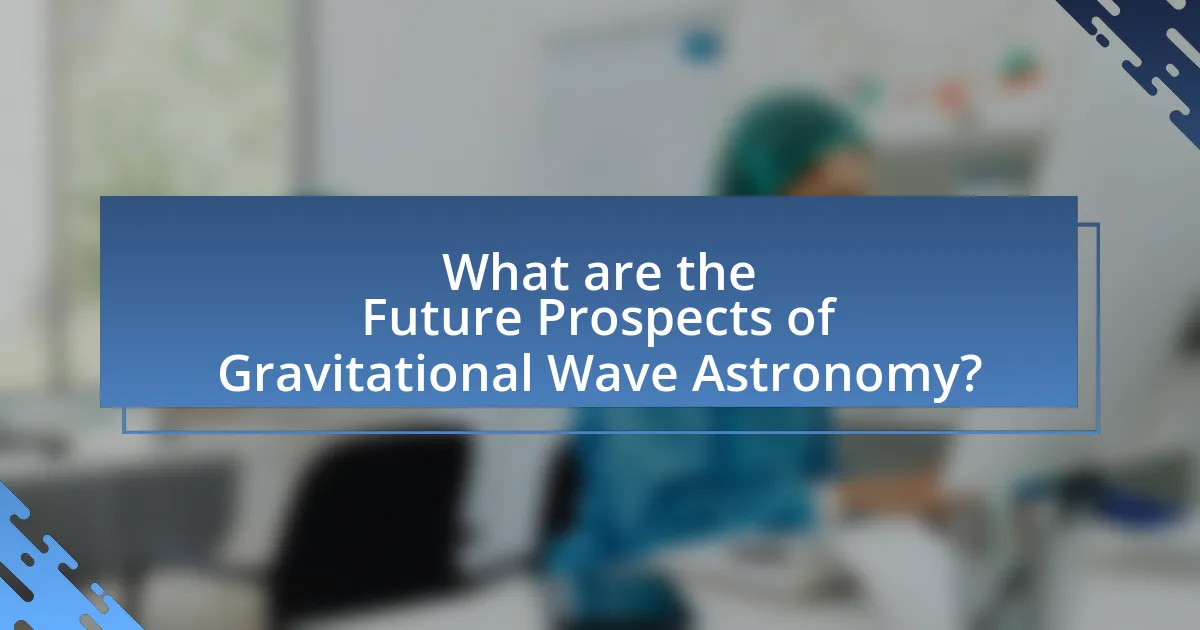
What are the Future Prospects of Gravitational Wave Astronomy?
The future prospects of gravitational wave astronomy are highly promising, with advancements in detector sensitivity and new observatories expected to enhance our understanding of the universe. Upcoming projects like the Einstein Telescope and the Cosmic Explorer aim to significantly increase detection rates of gravitational waves, allowing for the observation of more diverse astrophysical events, such as neutron star mergers and black hole collisions. These developments will enable scientists to probe fundamental questions about the nature of gravity, the formation of black holes, and the evolution of the universe, as evidenced by the successful detection of gravitational waves from binary black hole mergers by LIGO and Virgo, which has already opened a new era in astrophysics.
How will upcoming technologies enhance Gravitational Wave detection?
Upcoming technologies will enhance Gravitational Wave detection by improving sensitivity and expanding the frequency range of detectors. Advanced laser interferometry, such as that used in the next-generation LIGO and Virgo detectors, will allow for the detection of weaker signals from more distant cosmic events. Additionally, the integration of quantum technology, like squeezed light, will reduce noise levels, thereby increasing the precision of measurements. These enhancements are supported by ongoing research and development, including the European Space Agency’s LISA mission, which aims to detect gravitational waves in the low-frequency band, enabling the observation of events like supermassive black hole mergers.
What advancements are being made in detector sensitivity?
Advancements in detector sensitivity are primarily focused on improving the performance of gravitational wave detectors, such as LIGO and Virgo. These improvements include the implementation of advanced technologies like squeezed light, which enhances the precision of measurements by reducing quantum noise, and the use of more sensitive photodetectors that can detect weaker signals. For instance, LIGO’s sensitivity has increased by a factor of two since its initial design, allowing it to detect gravitational waves from more distant and fainter astronomical events. Additionally, ongoing upgrades aim to extend the frequency range of detection, enabling the observation of a broader spectrum of gravitational wave sources.
How will space-based observatories contribute to this field?
Space-based observatories will significantly enhance the study of gravitational waves by providing a stable and unobstructed environment for detection. These observatories, such as the Laser Interferometer Space Antenna (LISA), are designed to measure the minute distortions in spacetime caused by gravitational waves, which terrestrial observatories may struggle to detect due to atmospheric interference and seismic noise. LISA, set to launch in the 2030s, will utilize three spacecraft positioned in a triangular formation to achieve unprecedented sensitivity to low-frequency gravitational waves, enabling the observation of events like merging black holes and neutron stars. This capability will allow astronomers to gather crucial data on the universe’s most energetic phenomena, thereby advancing our understanding of cosmic events and the fundamental nature of gravity.
What challenges does Gravitational Wave astronomy face?
Gravitational Wave astronomy faces several significant challenges, primarily related to sensitivity, noise, and data analysis. The detection of gravitational waves requires extremely sensitive instruments, such as LIGO and Virgo, which must be able to measure displacements on the order of one-thousandth the diameter of a proton. This sensitivity is hindered by environmental noise, including seismic activity and thermal fluctuations, which can obscure the signals. Additionally, the vast amount of data generated during observations necessitates advanced data analysis techniques to distinguish genuine signals from noise, a task that is computationally intensive and complex. These challenges collectively impact the ability to detect and interpret gravitational wave events accurately.
How can noise and interference affect Gravitational Wave signals?
Noise and interference can significantly degrade the quality of Gravitational Wave signals, making it challenging to detect and analyze them accurately. Environmental factors such as seismic activity, thermal fluctuations, and electromagnetic interference introduce noise that can mask the faint signals produced by cosmic events like black hole mergers. For instance, the Advanced LIGO detectors, which are designed to measure these waves, must filter out noise from various sources to isolate the gravitational signals, as demonstrated during the detection of the first gravitational wave event, GW150914, where extensive noise reduction techniques were crucial for identifying the signal amidst background disturbances.
What are the limitations of current detection methods?
Current detection methods for gravitational waves face several limitations, including sensitivity, frequency range, and noise interference. These methods, such as LIGO and Virgo, are primarily sensitive to specific frequency bands, limiting their ability to detect waves from all astrophysical sources. For instance, LIGO is most effective in the frequency range of 10 Hz to 1 kHz, which excludes signals from events like supernovae that may emit lower frequency waves. Additionally, environmental noise, such as seismic activity and thermal fluctuations, can obscure signals, reducing the reliability of detections. These constraints hinder the comprehensive observation of gravitational waves across the universe, impacting the overall understanding of cosmic events.
What practical applications can arise from Gravitational Wave research?
Gravitational wave research can lead to practical applications in astrophysics, cosmology, and technology development. By detecting and analyzing gravitational waves, scientists can gain insights into the properties of black holes and neutron stars, enhancing our understanding of the universe’s fundamental processes. For instance, the observation of gravitational waves from merging black holes has provided data that can refine models of stellar evolution and the formation of galaxies. Additionally, the technology developed for gravitational wave detectors, such as advanced laser interferometry, has potential applications in fields like precision measurement and sensing technologies, which can be utilized in various industries, including telecommunications and medical imaging.
How might Gravitational Wave findings influence technology development?
Gravitational wave findings may significantly influence technology development by advancing sensor technology and data analysis methods. The detection of gravitational waves requires highly sensitive instruments, such as LIGO, which utilize laser interferometry to measure minute changes in distance caused by passing waves. This technology has led to improvements in precision measurement tools, which can be applied in various fields, including telecommunications and manufacturing. Additionally, the complex data analysis techniques developed for interpreting gravitational wave signals, including machine learning algorithms, can enhance capabilities in other domains like medical imaging and climate modeling. These advancements demonstrate how gravitational wave research can drive innovation across multiple technological sectors.
What interdisciplinary collaborations are emerging from this field?
Emerging interdisciplinary collaborations in the field of gravitational waves and modern astronomy include partnerships between astrophysicists, cosmologists, and data scientists. These collaborations leverage advanced computational techniques and machine learning to analyze vast datasets generated by gravitational wave observatories like LIGO and Virgo. For instance, the integration of data science methodologies has enhanced the detection and characterization of gravitational wave events, leading to significant discoveries such as the observation of neutron star mergers. This collaborative approach not only accelerates research but also fosters innovation in related fields, such as high-energy physics and quantum mechanics, demonstrating the broad impact of gravitational wave studies on various scientific domains.
